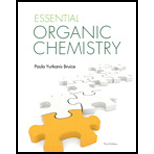
Concept explainers
Interpretation:
From the given species, species with greater delocalization energy have to be identified.
Concept Introduction:
Delocalization energy: It is a measure of how much more stable a compound with delocalized electrons is than it would be if its electrons were localized. The greater the number of relatively stable resonance contributors, the greater the delocalization energy.
Resonance Contributor: The appropriate structure with the localized electrons is called a resonance contributor, a resonance structure, or a contributing resonance structure.
Delocalized electrons: The sharing of electrons between two or more atoms known as delocalization of electrons. In order to have delocalized electrons, the system must be planar and have alternative double bonds and single bonds.
Resonance hybrid: The actual structure with delocalized electrons is called a resonance hybrid.
Want to see the full answer?
Check out a sample textbook solution
Chapter 7 Solutions
Pearson eText for Essential Organic Chemistry -- Instant Access (Pearson+)
- Cymbalta (shown below) is an antidepressant. How many asymmetric centers are present in this structure? SIN N.arrow_forwardWhy are these two conformational isomers? I was under the impression that in molecules with only sigma bonds, the bonds can rotate freely, and so the placement of the chlorines wouldn't matter?arrow_forwardIf cyclopentane were planar and each eclipsing interaction costs 4.0 kJ/mol, how much torsional strain will the planar cyclopentane have?arrow_forward
- Draw the bond-line structure of the compound (1R)-1-chloro-1-cyclohexylpropan-1-olarrow_forwardone of the chair structures of cis-1-chloro-3-methylcyclohexane is more stable than the other by 15.5 kj/mol (3.7kcal/mo) which is it ? what is the energy cost of a 1,3-diaxial interaction between a chlorine and a methyl group?arrow_forwardThe superoxide ion, O2- , plays an important role in the ageing processes that take place in organisms. Judge whether O2- is likely to have a higher or lower dissociation energy than O2 .arrow_forward
- The barrier to C-C bond rotation in bromoethane is 15 kJ/mol. What energy can you assign to an H-Br eclipsing interaction? Use strain energy increments from the table below in your calculation. Interaction (Specify units, kJ/mol; Calculate to nearest 0.1 energy units) H → H eclipsed H → CH3 eclipsed CH3 → CH3 eclipsed CH3 CH3 gauche Cause Torsional strain Mostly torsional strain Torsional and steric strain Steric strain (kJ/mol) Energy cost 4.0 6.0 11.0 3.8 (kcal/mol) 1.0 1.4 2.6 0.9arrow_forward19. Based on molecular mass and dipole moment of the five compounds in the table below, which one should have the highest boiling point? Dipole Moment (D) Substance Molecular Mass (amu) Propane, CH3CH2CH3 Dimethyl ether, CH3OCH3 Methylchloride, CH3C1 Acetaldehyde, CH;CHO Acetonitrile, CH3CN 44 0.1 46 1.3 50 1.9 44 2.7 41 3.9 B) CH;CN E) CH3CH2CH3 C) CH3CHO A) CH3OCH3 D) CH;CIarrow_forwardwhich is more polar, H-Se or H-I?arrow_forward
 ChemistryChemistryISBN:9781305957404Author:Steven S. Zumdahl, Susan A. Zumdahl, Donald J. DeCostePublisher:Cengage Learning
ChemistryChemistryISBN:9781305957404Author:Steven S. Zumdahl, Susan A. Zumdahl, Donald J. DeCostePublisher:Cengage Learning ChemistryChemistryISBN:9781259911156Author:Raymond Chang Dr., Jason Overby ProfessorPublisher:McGraw-Hill Education
ChemistryChemistryISBN:9781259911156Author:Raymond Chang Dr., Jason Overby ProfessorPublisher:McGraw-Hill Education Principles of Instrumental AnalysisChemistryISBN:9781305577213Author:Douglas A. Skoog, F. James Holler, Stanley R. CrouchPublisher:Cengage Learning
Principles of Instrumental AnalysisChemistryISBN:9781305577213Author:Douglas A. Skoog, F. James Holler, Stanley R. CrouchPublisher:Cengage Learning Organic ChemistryChemistryISBN:9780078021558Author:Janice Gorzynski Smith Dr.Publisher:McGraw-Hill Education
Organic ChemistryChemistryISBN:9780078021558Author:Janice Gorzynski Smith Dr.Publisher:McGraw-Hill Education Chemistry: Principles and ReactionsChemistryISBN:9781305079373Author:William L. Masterton, Cecile N. HurleyPublisher:Cengage Learning
Chemistry: Principles and ReactionsChemistryISBN:9781305079373Author:William L. Masterton, Cecile N. HurleyPublisher:Cengage Learning Elementary Principles of Chemical Processes, Bind...ChemistryISBN:9781118431221Author:Richard M. Felder, Ronald W. Rousseau, Lisa G. BullardPublisher:WILEY
Elementary Principles of Chemical Processes, Bind...ChemistryISBN:9781118431221Author:Richard M. Felder, Ronald W. Rousseau, Lisa G. BullardPublisher:WILEY





